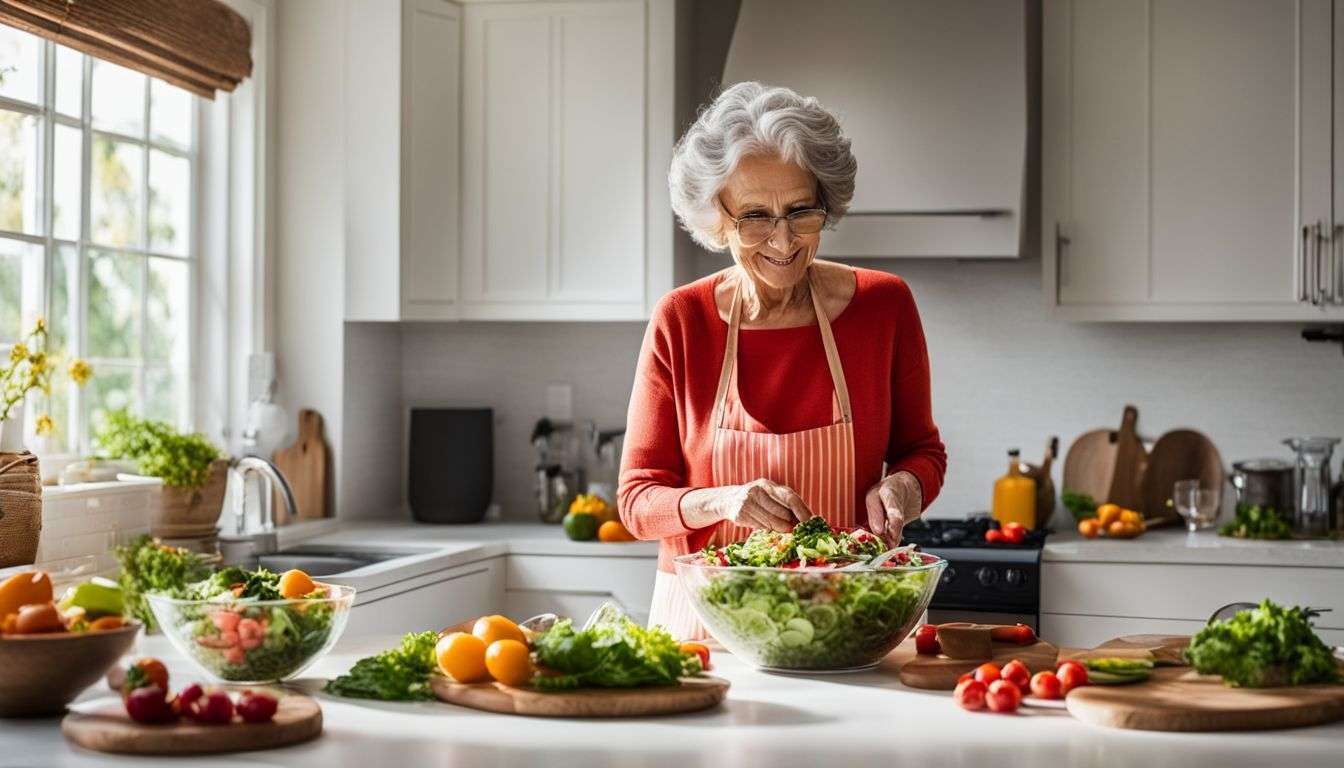Ever noticed that afternoon slump hitting harder than it used to? Turns out, boosting your fiber intake could be the secret weapon for those energy dips. Packed with perks, a high-fiber snack does more than just tide you over until dinner—it’s a vitality vault for seniors! In this quick read, we’ll unwrap the gift of fiber and how it can revamp your health game.
Ready to feel fabulous? Let’s dive in!
Key Takeaways
- High-fiber snacks help seniors feel full, which can lead to healthy weight loss and control. Eating fiber-rich foods like oat bran muffins or apple slices with peanut butter helps fight hunger pangs and keep weight in check.
- Good fiber intake is linked to a lower chance of getting type 2 diabetes and heart disease. Foods high in fiber make blood sugar rise slowly, which is good for keeping the heart and blood sugar levels healthy.
- Fiber-rich foods are great for digestion and regular bowel movements. Insoluble fibers add bulk to stools, making it easier for seniors to stay regular and avoid constipation.
- A diet high in fiber supports a thriving community of good bacteria in the gut, boosting the immune system. These friendly bugs love fiber and help protect against bad germs.
- Fiber may reduce the risk of some cancers like colorectal cancer for all people and breast cancer for women. Eating lots of fruits, veggies, and grains packed with fiber could help fend off these diseases.
Understanding Dietary Fiber

Alright, let’s chat about dietary fiber – you know, that nifty stuff your doctor keeps saying you should have more of? Especially for you seniors out there, it’s like the unsung hero of your pantry.
But what is this mysterious fiber? Let me tell ya’, it’s not just for helping with the ol’ digestive ballet (though it’s a champ at that) but also packs a punch against some pesky health gremlins.
Now, fasten your seatbelts; we’re diving deep into fiber town – no technical jargon guaranteed!
What is Fiber?
Fiber is the part of plants that your body can’t digest. It’s like nature’s broom, sweeping through your belly and keeping everything moving right along. There are two main types: soluble fiber and insoluble fiber.
Soluble fiber dissolves in water to form a gel-like stuff which helps keep blood sugar and cholesterol levels in check. Think of oats, barley, nuts, seeds, beans, lentils, peas – they’re all packed with it!
Now – let’s talk about the rough-and-tough kind: insoluble fiber doesn’t dissolve; it hangs out in your digestive system making sure foods move through smoothly so you don’t get blocked up.
Whole wheat breads, brown rice, legumes – these guys are loaded with this type of roughage! Eating lots of fruits and veggies also boosts your intake because they’re full-fat fibers without even trying.
Plus – oh boy – does it help fill you up! Ever munched on an apple or chowed down some carrots and felt pretty darn satisfied? That’s all thanks to our friend fiber doing its thing.
Why is it Vital for Seniors?
Seniors need to eat more fiber for a bunch of good reasons. It helps them stay at a healthy weight and lowers their chance of getting sick with things like heart disease or type 2 diabetes.
Experts say older folks should aim for about 28-34 grams of fiber each day, but most don’t get enough.
Eating plenty of fiber keeps the digestive system on track, reducing constipation which can be a big problem as we age. All those fruits, veggies, and whole grains make sure everything flows smoothly in the guts.
Plus, this kind of diet is great for keeping blood sugar levels steady and helping bones stay strong.
Health Benefits of High-Fiber Diet for Seniors

Alright, let’s dive into the juicy part – we’re talking about high-fiber foods and seniors here! Imagine a world where munching on crunchy, fiber-rich snacks can practically turn back the clock on your health.
This isn’t just some fairy tale; for the golden-agers among us, loading up on fiber is like having a secret weapon in their wellness arsenal. So, put down that doughnut (tempting as it may be), and let’s explore why getting friendly with fiber could be your best move yet!
Promotes Healthy Weight Loss and Control
Eating high-fiber snacks helps seniors keep a healthy weight. Fiber makes you feel full, so you eat less without trying too hard. Soluble fiber is the kind that can lower cholesterol and blood sugar, which also plays a part in managing weight.
On the other hand, insoluble fiber keeps things moving in your gut and adds bulk to stools. This means your body can say goodbye to waste easier and quicker – which is great for keeping your stomach flat.
Now imagine snacking on some oat bran muffins or crunchy apple slices with peanut butter. Sounds yummy, right? These tasty treats pack a bunch of fiber that works like magic for weight control; they help stop those pesky hunger pangs that make you want to eat more.
Plus, they’re better than munching on chips or cookies when you need a little something between meals. High-fiber goodies really are superstars at helping seniors stay fit and trim!
Reduces Risk of Type 2 Diabetes
Eating lots of fiber can help seniors stay away from type 2 diabetes. It’s like a superhero for the body, keeping blood sugar levels in check. Imagine this: when you chow down on high-fiber foods, your body has to work harder to break them down.
This means sugar enters your bloodstream slowly and doesn’t spike all at once. The Institute of Medicine says older folks should eat enough fiber every day to keep their blood sugar steady.
Now, let’s talk about something that keeps everyone ticking – the heart!
Lowers Odds of Heart Disease
Fiber is like a superhero for your heart! The more of it you eat, the better your chances are of keeping heart disease away. Imagine your heart giving you a big thumbs-up when you choose an apple over a bag of chips.
Foods packed with fiber make it tough for bad cholesterol to stick around, helping keep blood flowing smoothly and easily.
Now, picture this: munching on some oatmeal or snacking on black beans can actually guard against cardiovascular disease (that’s doctor’s talk for problems with your heart and blood vessels).
And guess what? Science backs this up – increasing that fiber intake is key to cutting down the risk. So next time you’re about to grab a bite, reach for something high in fiber; your heart will thank you big time!
Supports Healthy Gut Bacteria
After looking at the heart, let’s move to the gut. High-fiber snacks feed the good bugs in your belly. These tiny helpers make up your gut microbiome and they love munching on fiber.
Think of it like a garden party down there – when you send in lots of fiber, it’s like serving up the best snacks that keep all your little guests happy and thriving.
Having a bustling bash in your belly helps with more than just digestion – it can also boost your immune system! You see when those good bacteria chow down on high-fiber foods, they produce substances that help fight off bad germs.
So by snacking on things like fruits, veggies, and whole grains, not only do you keep things moving smoothly through your GI tract – but you’re also building up a strong defense team inside you!
Reduces Risk of Certain Cancers
Eating a lot of fiber can be like having a secret weapon against some cancers. Think about colorectal cancer. Folks who munch on high-fiber foods, especially whole grains, are less likely to get it.
Now that’s good news! And for the ladies, there’s even more reason to love fiber – it can help keep breast cancer away.
Yep, grabbing an apple or some whole-wheat toast might do more than just fill you up. The American Cancer Society says eating lots of fruits, veggies, and grains packed with fiber is smart for keeping cancer at bay.
It’s pretty amazing what those fibers in your snack can do. They’re not just there to keep things moving along in your gut; they’re busy fighting off big health baddies like cancer too! So next time you reach for a snack, pick something high in fiber – your body will thank you for it later.
Contributes to Regular Bowel Movements
Fiber is kind of like a broom for your insides. It sweeps through and helps everything move along smoothly – yep, we’re talking about bowel movements here! For seniors especially, staying regular can become a real hassle.
But with enough fiber in their snacks and meals, they don’t have to worry as much about getting constipated. Insoluble fibers are the champs at this job since they don’t dissolve in water and add bulk to waste in the digestive system.
Imagine turning that slow-moving river into a swift stream; that’s what fiber does inside you. It keeps things flowing so you can feel light and lively, not bloated or weighed down by what should have left your body already.
Remembering those dietary guidelines – 30 grams for men and 21 grams for women over 51 – is super important because it’s all about hitting the right numbers to stay on track health-wise.
Helps in Natural Detoxification
Having regular bowel movements is one sign your body’s getting rid of waste. High-fiber snacks go a step further by acting like nature’s broom, sweeping through our digestive system and cleaning up the bad stuff along the way.
Fiber grabs onto toxins and other unwanted guests in our gut, then says goodbye to them when we go to the bathroom.
Not only does this keep things tidy inside us—but this natural detox helps protect against nasty health problems too. Eating plenty of fiber-rich foods can latch onto harmful compounds in the food we eat, making sure they don’t stick around for trouble.
So go ahead, munch on those high-fiber treats; your insides will thank you for helping them stay spotless!
Strengthens Bones
High-fiber snacks aren’t just about keeping your tummy happy. They’re like a secret weapon for your bones! Imagine munching on almonds or chowing down on some tasty chickpeas, and with every bite, you’re helping your skeleton stay solid.
Cool, right? Doctors say eating stuff packed with fiber helps seniors keep their bones tough. This means there’s less chance of breaks or cracks if you take a tumble.
Now think about this – while you savor that crunchy apple or those yummy sprouts, your body’s soaking up calcium and magnesium better because of the fiber in these foods. It’s like giving your bones a power-up; they soak in all that good stuff to stay strong as steel! So go ahead, grab a high-fiber granola bar, and give those bones some love.
They sure deserve it after many years of dancing, running, and bear-hugging grandkids!
Best High-Fiber Foods for Seniors

Eating high-fiber foods is key for seniors wanting to stay healthy. These foods help keep digestion on track and can even protect against some diseases. Let’s look at some top choices:
- Oats are soft, easy to eat, and full of soluble fiber. This kind of helps the heart by lowering bad cholesterol.
- Beans like navy beans, lentils, and chickpeas are great in salads or soups. They pack a lot of fiber and protein in every bite.
- Apples have a type of fiber that’s good for you – just don’t peel them! The skin has the most fiber.
- Citrus fruits such as oranges and grapefruits also have soluble fiber. They’re juicy, tasty, and refreshing.
- Carrots are crunchy and full of nutrients. Add them raw to salads or cook them as a side dish.
- Barley can be used in place of rice for an extra fiber boost. It goes well in stews too.
- Psyllium is found in some cereals and is often used in fiber supplements. But check with a doctor before trying these.
- Whole-wheat flour makes breads and pastas better for seniors than white flour versions. They contain insoluble fiber that helps prevent constipation.
- Wheat bran can be sprinkled on yogurt or mixed into baked goods for an extra dose of insoluble fiber.
- Nuts, especially walnuts, add crunch to meals or snacks while giving a healthy serving of fiber.
Tips for Increasing Fiber Intake in Seniors

Alright, let’s talk about how to get more fiber into the diets of seniors. This is super important for helping them stay healthy.
- Start slow with fiber to keep bellies happy. Too much too fast can cause gas or cramps.
- Make breakfast a fiber boost by picking cereals full of whole grains.
- Swap out that regular flour! Use whole-grain flour when you’re baking something yummy.
- Beans and peas are your friends. Add these legumes to meals for an extra fiber kick.
- Go for fruit and veggie snacks instead of chips. Fresh pieces or dried fruits work well.
- Snack time? Think about high-fiber options like popcorn or whole-wheat crackers.
- Drink water, lots of it. It helps fiber do its job and keeps everything moving along.
Conclusion
So, now you know—high-fiber snacks are awesome for seniors! They help keep the body strong and can chase away some serious health problems. Remember, adding these goodies to your diet can make a big difference in how you feel each day.
Say yes to fiber-rich foods and give your body the love it deserves! Keep on munching those high-fiber treats; your tummy—and heart—will thank you!
FAQs
1. Why are high-fiber snacks good for seniors?
Well, munching on high-fiber snacks can be a game-changer for seniors! They help keep things moving in the intestinal tract – if you know what I mean (helps with digestion). Plus, they’re champs at lowering blood cholesterol levels and managing glucose levels.
2. Can eating fiber-rich foods help seniors lose weight?
Absolutely! High-fiber foods like whole-wheat pasta and beans make you feel full without loading up on calories… It’s like nature’s little trick to help with weight management without feeling starved.
3. What are some high-fiber snack ideas that taste good?
Oh, get ready for this – how about an apple with peanut butter or maybe whole-grain crackers topped with cheese? And let’s not overlook the humble bowl of breakfast cereal; just pick one that’s got those higher fiber numbers on the box!
4. Do fiber snacks do more than just help with regularity?
You bet they do! High fiber diets have a bunch of bonuses: think less risk of scary stuff like cancer and cardiovascular disease… plus, they can even regulate blood sugar which is super important to keep an eye on!
5.Will eating more fiber cause tummy troubles for seniors?
Here’s the scoop – if someone isn’t used to a lot of fibers and suddenly starts downing chickpeas by the can… yeah, there could be some trouble (like gas or bloating). But hey, ease into it slowly and drink plenty of water to stay ahead in the game.
6.Are only natural foods high in fiber or can I find it in other products too?
Guess what? There are loads of fortified foods out there where extra fibers have been added—think breads (just skip over white breads), juices, and even snack bars. So yes, along with fruits veggies ‘n grains, you’ve got options galore!





